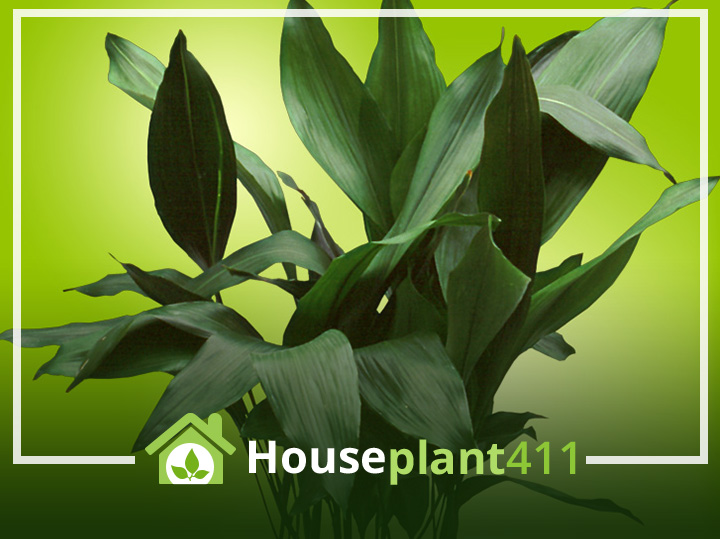About
Aspidistra elatior or the Cast Iron plant, native to China, Japan, and Taiwan, is an almost indestructible easy-care plant that survives where other houseplants quickly die. It’s a member of the Asparagaceae family and is a relative of the spider plant (which it does not resemble in the least). A Cast Iron plant is sometimes referred to as an Iron plant or a Ballroom Plant.
Cast Iron Plant Description
This is a rather plain plant with long, lancet shaped, pointed, course textured, leathery leaves that emerge directly from the soil. The leaves are over a foot long and 5” wide. Every individual leaf on the plant is grown on it own stem. You can separate a stem and its roots from the plant and propagate a new plant. When a cast iron plant is grown outdoors, it sometimes produces inconsequential purple and white flowers around the base of the plant. When grown as an indoor houseplant, it very rarely blooms.
Cast Iron Plant Varieties
There are several different varieties of the cast iron plants:
Variegated (Aspedistra “Ippin” and Aspedistra “Okame”) have lancet shaped green leaves with cream – colored stripes.
“Starry Night” has semi-glossy green leaves decorated with white or yellow small dots.
“Lennon’s Song” has dark green, long, narrow, lancet shaped leaves with an irregular pale yellow central stripe.
“Asahi” has green leathery leaves that develop white tips as the plant matures.
“Akebono” has 2-3ft long leaves with a cream or pale yellow stripe running down the center of each leaf.
The leaves on all of varieties revert back to solid green when the plant is in very low light.
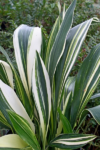
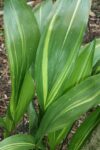
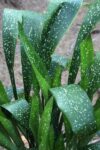
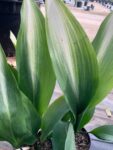
A. Variegated A. Variegated A. Starry Night A. Asahi
Conclusion
A Cast Iron plant is perfect for someone with a brown thumb or if you want to put a plant in an area where no other plant can possibly survive. They forgive you if you forget to water but develop root rot is you water too much. They can survive in low light, but the leaves get bleached if the light is too strong. This is the type of green friend that can only be “killed with kindness.
Plant Care
Light
How much light for a cast iron plant: A cast iron plant grows in any low-light to bright, filtered light area. When the light is too bright, the color in the leaves starts to fade and older leaves may turn brown.
Water
How to water a cast iron plant: Allow the top 50% of the soil to dry out before watering. The lower the light the less often a cast Iion plant needs to be watered. In very low light, this plant may need water only every 2-3 weeks. over watering is the main reason a cast iron plant dies.
Fertilizer
How to fertilize a cast iron plant: Feed monthly with a balanced plant food diluted to 1/2 the recommended strength. Fertilize a cast iron plant only when it it actively growing.
Temperature
What is the best temperature for a cast iron plant: A cast iron plant does well in temperatures between 50°F-75°F (10°C-23.9°C). This plant can even survive in temperatures as low as 45°F(7.2°C).
Humidity
How much humidity for a cast iron plant: Regular household humidity is fine for a cast iron plant.
Flowering
Does a cast iron plant flower: Although a cast iron plant is a member of the lily family, its flowers are very small and inconsequential. The flowers appear near the surface of the soil and are often hidden by the leaves. The purple/brown colored flowers are about an inch long and after they die, a dark red berry may appear. an indoor cast iron plant rarely flowers.
Pests
Cast iron plant pests: A cast Iron plant is susceptible to mealy bugs and spider mites. Because of the simple leaf structure, pests are easily treated. Read more about these pests and how to treat them the in the Glossary of the website.
Diseases
Cast iron plant disease: Leaf Spot disease caused by fungal and bacterial infections can be a problem. Provide good air circulation and keep the leaves of a cast iron plant dry to prevent diseases. Read more about Leaf Spot disease and how to recognize and treat it in the Glossary of the website.
Soil
What kind of soil for a Cast Iron plant: Use a rich organic indoor potting soil such as an African Violet mix.
Pruning
How to prune a cast iron plant: A iast Iron plant rarely needs to be pruned.
Propagation
How to propagate a cast iron plant: A cast Iron plant is propagated by plant division. Read more about plant propagation techniques in the Glossary. Another unique way to propagate a cast iron plant, is to remove a leaf stem and its roots and plant it in a very small pot of African violet soil.
Poisonous Plant Info
Is a cast iron plant poisonous: This is a non-poisonous plant and is not toxic to cats, dogs, or children.
FAQ
Cast Iron plant lose their white stripe when the light is too low. If you want the leaves to regain their white stripe, you’ll have to move your plant to brighter light. The more color in the leaves, the more light a plant requires.
If you move your Cast Iron plant to a low-light and a cool area it will be fine for three weeks.
The stems of a Cast Iron plant are below the soil. The leaves only look like they don’t have stems.

